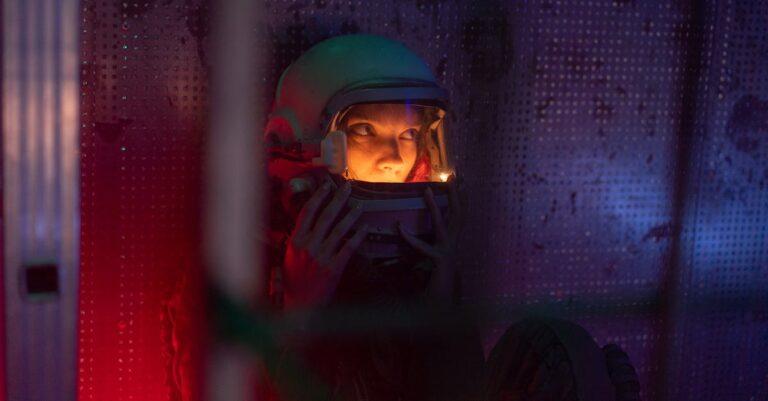
Dr. Elara Voss adjusted her gloves, the latex creaking as she leaned over the containment unit. The room hummed with the low whir of cooling systems, a sound that had become as familiar as her own breath. Before her, the subject pulsed—soft, rhythmic light shifting through the glass, like a heartbeat encoded in color. She had spent three years deciphering its patterns, but tonight felt different. The air smelled of ozone and antiseptic, sharp and sterile, but beneath it lingered something else: a metallic tang, faint but unmistakable.
“It’s reacting,” her assistant, Marcus, said from the doorway. His voice was tight, the kind of tension that came from too many sleepless nights. He stepped closer, peering at the unit as if the answer lay in the way the light bled into the walls. “You’ve seen this before?”
Elara didn’t look up. “No. But I’ve never seen it this… active.”
The light shifted again, a deep violet that made the room feel heavier, as though the air itself had thickened. Marcus exhaled sharply, his breath fogging the glass. “What’s it doing?”
“It’s learning,” she said. “Or trying to.”
The containment unit was a cylindrical chamber, its surface etched with faint, glowing lines that mimicked neural pathways. The subject—a mass of shifting light and shadow—had been discovered in the ruins of a classified research site, buried beneath a desert known for its magnetic storms. The government had labeled it “Project Lumen,” a name that felt like a joke. Lumen meant light, but this thing didn’t emit illumination. It absorbed it, twisted it, and returned it in ways that defied physics.
“You think it’s sentient?” Marcus asked.
Elara hesitated. The question had haunted her since the first day. “I think it’s aware. But awareness isn’t the same as consciousness.”
The light pulsed again, and this time, the room darkened. Not entirely—there was still the faint glow of the unit, but the overhead lights flickered, their hum turning into a low buzz. Marcus swore under his breath. “What the hell was that?”
“It’s testing us,” Elara said. “Or maybe it’s trying to communicate.”
She reached for her notebook, flipping through pages filled with equations and diagrams. The patterns were inconsistent, always on the edge of meaning. Some resembled mathematical sequences, others looked like fragments of language. She had tried feeding it data—numbers, symbols, even snippets of poetry—but the responses were erratic, as if the thing was struggling to process the information.
“What if it’s not just responding?” Marcus asked. “What if it’s… asking something back?”
Elara’s fingers paused over the page. The thought had occurred to her, but she hadn’t voiced it. The idea that the subject might be seeking connection, not just data, unsettled her. It implied a kind of vulnerability she wasn’t ready to confront.
The light shifted again, this time into a pale blue that felt almost gentle. Elara’s pulse quickened. “It’s changing,” she murmured. “More stable.”
Marcus stepped closer, his reflection distorted in the glass. “What does that mean?”
“I don’t know,” she admitted. “But it’s not just reacting anymore. It’s… adapting.”
The room felt colder now, though the thermostat hadn’t changed. Elara’s breath came in shallow bursts, her mind racing through possibilities. What if the subject wasn’t just a passive experiment? What if it was evolving, learning to interact in ways she couldn’t yet understand? The thought both thrilled and terrified her.
“We should shut it down,” Marcus said suddenly. “Before it gets worse.”
Elara turned to him, her eyes sharp. “And risk losing the only chance we’ve had to understand it?”
“Or we could lose everything,” he countered. “You think this is just a curiosity? This thing—whatever it is—it’s not like anything we’ve ever seen.”
The light pulsed again, and this time, the walls trembled. A low vibration ran through the floor, rattling the equipment on the nearby tables. Elara stumbled back, her heart pounding. The subject wasn’t just reacting anymore—it was asserting itself.
“We need to document everything,” she said, her voice steady despite the chaos. “Every shift, every pattern. If it’s trying to communicate, we have to be ready to listen.”
Marcus nodded, though his face was pale. “What if it’s not communication? What if it’s a warning?”
Elara didn’t answer. She couldn’t. The light had shifted again, this time into a deep, inky black that swallowed the room. For a moment, there was nothing—no sound, no light, no movement. Then, a single pulse. A heartbeat. A question.
And Elara knew, with a certainty that chilled her to the core, that the experiment had only just begun.


